|
|
 Tradition persane | 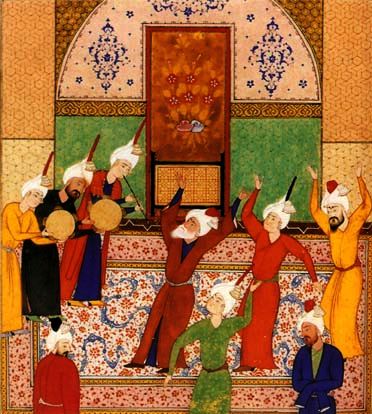 The study of the tradition Persian is a stage impossible to circumvent for any person who is interested in the multiple Eastern traditions like with the various musics of the Moslem world (of the Cashmere as far as Andalusia)! The study of the tradition Persian is a stage impossible to circumvent for any person who is interested in the multiple Eastern traditions like with the various musics of the Moslem world (of the Cashmere as far as Andalusia)!
What nowadays, is commonly called traditional music Persian, seems to be a pale reflection of a thousand-year-old heritage three times. The history places the beginning of this tradition around VIème century before J.-C. under the dynasty of Achéménides. As of this time, the music was closely related to the ritual monk of Zoroastriens. It perdure nowadays, of ancestral fragments of songs of this time.
With the advent of Islam in VIIème century after J.-C., the prohibition of arts, concerning the music, painting and the zoroastrism, radically modified the evolution of the music. As of this period the musical tradition conveyed in mediums of initiates and was transmitted from generation to generation by oral transmission. During these dark years, then begins a process of loss of the original repertory, and in parallel an evolution according to the contribution of the Islamic culture. It is advisable to note here, the considerable influence of the culture Persian in Islamic art. In the same way, it is interesting to notice that the musical system arabo-Turkish impressed same the expressions as the Persan system. It acts in the major part of the cases, of old expressions used in the courses royal of before the Islam of the dynasty of the sassanides. The XXème century sees Iran, like much country of the area, to launch out in an unrestrained race of modernity, under the reign of Pahlavi (the Shah). That will accentuate of advantage musical acculturation. The Islamic revolution of 1979, by prohibiting any Western source, contributed in spite of it to a new rise of the traditional music. It is indeed very interesting to notice at which point, the present generation is impassioned for this ancestral music.
Enregistrement in a concert live, shermin movaffaghi with the tar, jamal aghai tombak and saeed naghibzadeh recitation of poésies:
|
|  les modes | 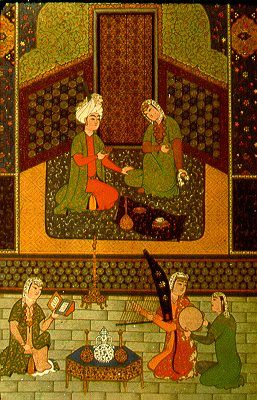 The Persan modal system is composed of 12 different modes. These modes belong them even to a broader unit called Dastgah. The Persan system of the modes which is the origin of many of other traditions to the characteristic to have microphones intervales that one nomist by simplification of the quarter tones. The connaisssance of its ranges can prove very useful in the assumption of responsibility of patients who come from an Eastern tradition, being given that its last have to weave their affectivities on the melodies which result from this. The Persan modal system is composed of 12 different modes. These modes belong them even to a broader unit called Dastgah. The Persan system of the modes which is the origin of many of other traditions to the characteristic to have microphones intervales that one nomist by simplification of the quarter tones. The connaisssance of its ranges can prove very useful in the assumption of responsibility of patients who come from an Eastern tradition, being given that its last have to weave their affectivities on the melodies which result from this.
Dastgahe SHOUR, is the system more used in the music Persian. It indexes all the Iranian folk musics. By its balanced structure, it is the mode more appreciated Iranian. It counts 5 different forms which have each one their own specificity: Abou-ATA, Dashti, Korede Bayate, Bayate Tork and Afshari the scale of interval of this system is as follows: (3/4; 3/4; 1; 1; 1/2; 1; 1)
Dastgahe Mahour, is a very old, known system of Zoroastriens, and which seems to be at the origin of the Western major mode. It is characterized by its lightness. From this point of view, Mahour is the mode of the joy Ses intervals are: (1; 1; 1/2; 1; 1; 1; 1/2)
Dastgahe Homayoun, is par excellence the mode of the meditation. It combines spirituality and nostalgia: (3/4; 5/4; 1/2; 1; 1/2; 1; 1)
Its only modulation is esfahan which is connected with a minor mode where the sixth is decreased by 1/4 of tone. Dastgahe SEGAH, is a mode appreciated in the west of Iran; it forms also part of the music of Azerbijan (Turkey Western). It has like specificity to have three quarter tones: (3/4; 1; 3/4; 1; 3/4; 1; 3/4) Gousheye mochalef, is a modulation where there is polarization on the sixth. Dastgahe TCHARGAH: it acts of Dastgahe more stereotyped in occident. It has an "Eastern" sonority typically. According to specialists' Tchargah is one of the oldest modes of the Persan system: (3/4; 5/4; 1/2; 1; 3/4; 5/4; 1/2)
Dastgahe NAVA is the mode of the enchantment. It is connected in Shour, but is different by the presence from a quad which confers a strange dimension (1 to him; 1/2; 1; 1; 3/4; 3/4; 1) Dastgahe RASTPANJGAH, is most complete Dastgahe of all bus it makes it possible to the interpreter to play all the other modes except for Tchargah. Its structure resembles a major mode whose sensitive one would be lowered of a quarter tone: (1; 1; 1/2; 1; 1; 1/2; 1)
Table of the correspondence of the system modal mode Heure execution Couleur element character shour Between 10-12 Red fire fire meditation mahour After twilight Bleu sky wind joy homayoun During Vert twilight sinks flame attraction Nava Heure of laying down transparent Combinaison wind and fire council segah dark the Bleu afternoon variable water chahargah Tôt the Blanc morning and yellow vapor excitation rastpanjgah matiné bronzes ground concentration esfahan clear Vert paddle Amour light
The rates/rhythms
The Persan rhythmic system is not as complex as the Indian system for example. Its complexity lies in its smoothness of execution (rhythmic stressings). In a general way, the major part of the parts borrow rates of 2/4, 3/4, 4/4, 5/4, 7/4, 8/4 and 12 times. The folk musics have a preference for a rate/rhythm made up of 6/8. Tcharmezrab, parts fast, are carried out in rates of 4/16 or 6/16. There is however a system of rates/rhythms escaping from a mathematical analysis. It acts of phrased Persan song. Being given the complexity of the system, we do not judge useful to develop it here. The processes of training of the rate/rhythm in the Eastern traditions are in general methods very interesting and useful in musicothérapie: Contrary to the Western approach which stresses the arithmetic dimension of the rate/rhythm, the Eastern ones privilege the geometry and the correspondences with the language. With each rate/rhythm will correspond for example a poetic sentence which will have the characteristic to highlight the rhythmic accents. From its tonal richness and its ancestral use in time that means therapeutic, the study of this tradition, like any other tradition in addition, brings a greater degree of freedom in musicothérapie, that it is a question of the capacity of joining the patient in his cultural Iso or of being able to widen the expressive register in the communication.
texte: Shermin Movaffaghi |
|  La musique et le soufisme | 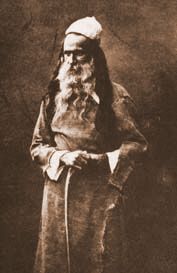
Le mysticisme musulman dont un développement est connu sous le nom du soufisme a crée au long de son histoire une multitude de traditions musicales très riche et variées, mêlant la dimension sacrée à une méthode pouvant amener à un bien être physique et mental que nous qualifions de thérapeutiques.
De part le nombre important de cultures que le soufisme a intégré, que l'on pense aux traditions centre africaines, aux civilisations moyenne-orientales et jusqu'au toit du monde au Tibet !
Cette richesse culturelle fait du soufisme dans son ensemble un magnifique réservoir de tradition et de savoir oral transmis de génération en génération.
Le soufisme tire son nom étymologiquement du grec qui signifie sagesse en ancien grec et habit de laine en arabe. Ce courant mystique de l'Islam s'est formé après l'Islamisation de la Perse qui auparavant pratiquait une des plus vieilles religions monothéistes qui est le Zoroastrisme.
Le soufisme se démarque dès son origine aux dogmes rigides et aux interprétations politiques de la religion.
A travers les siècles beaucoup de différentes confréries vont naître dont les chefs de fil sont de Grand Poètes mystiques (Halladj, Rumi, Khayam…)
Dans ces confréries, on développe peu à peu, selon les pays et les rituels en vigueurs, une propre tradition musicale.
Par exemple, l'on peut situer le fameux ordre des Derviches Tourneurs fondés par le poète persan Mowlana ; ou l'extraordinaire traditions des Qwali du Pakistan dont un des illustres représentants était le Ostad Fateh Ali Khan.
Au cours des siècles, les différents maîtres spirituels se sont rendus compte de l'importance de la musique dans les cérémonies de méditations et de prières.
De nos jours subsistent encore beaucoup de différentes confréries dont chacune a son répertoire propre. De plus, ces traditions ne se transmettent qu'aux gens initiés et sont pratiquées dans des cercles très fermés.
Bien qu'elle soit souvent différente quant aux aspects esthétiques ou culturels, la musique et son utilisation, a toujours la même fonction :
1. Dans un premier temps, de créer une ambiance qui va créer la motivation tout en étant relaxante.
2. Par des incantations répétitives, la musique va mobiliser les facultés attentionnelles.
3. Etant donné qu'il s'agit d'un processus groupal, la musique va renforcer les liens du groupe et permettre le sentiment d'unité.
4. La transe, si elle a lieu, permettra de vivre une expérience cathartique et dé libérer les tensions.
Dans certaine traditions, par exemple, des Derviches du Baloutchistan, ces cérémonies ont aussi parfois une visée thérapeutique.
Dans d'autres traditions on peut assister à des comportements auto-mutilatoires sous hypnose.
C'est ainsi que l'on voit parfois, enivrés par des rythmes frénétiques certains soufis manger des clous, des lames de rasoirs et même de se percer avec des poignards.
Bien que ces comportements n'aient pas un intérêt dans la recherche du bien-être, mais ils montrent l'importance des effets hypnotiques induits par la musique.
En musicothérapies, les rituels soufis ne peuvent pas être utilisés car étant en dehors de leur contexte sociale et culturel.
Par ailleurs le but et la finalité d'une consultation musicothérapie n'est pas forcément la recherche du sacré ou de l'unicité.
Mais toute fois cette pratique peut nous apprendre une méthodologie quant à l'utilisation de la transe en situation de groupe et la recherche d'un état de bien-être.
Ayant pu assister à quelques séances de transe collective, j'ai été impressionné par l'utilisation du rythme et du tempo pour l'induction de cet état. |
|  The relation between Master and Student | 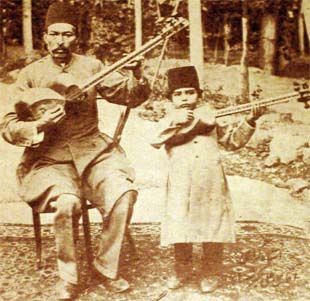 | As we saw previously, the transmission of the music as its training are done in the intimacy of a relation of Master with pupil, and as say it Eastern chest to chest. It is obvious that in such a proximity, tranferential relations can be born.
Same manner, that a trained therapeutist manages to work with the transfer, the traditional Master uses the transfer in its "musical cure". The pupil beginning can for example project at the beginning the image of a very powerful and authoritative father who with the passing of years can become rival which finally will be a true and respected friend. The Master, in the same way that a therapeutist represents the stable universe, allows to work in "here and now". |
|  Le Hal: lien entre musicothérapie et traditions orales | 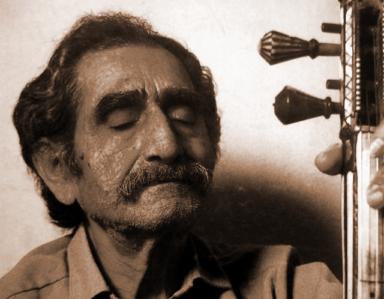 Le terme Hal qui signifie en persan, le moment présent, l'ici et le maintenant et aussi l'état de santé. Le terme Hal qui signifie en persan, le moment présent, l'ici et le maintenant et aussi l'état de santé.
Dans la musique persane, la qualité d'une musique ou d'un musicien ne se mesure pat tant par sa virtuosité mais plutôt par cette capacité d'être en phase avec le moment choisi.
Une interprétation qui a du Hal est une interprétation qui tient compte du ici et du maintenant des musiciens et du public.
Il s'agit d'une adéquation magique où le sonore entre en résonnance avec l'état de réceptivité des auditeurs.
N'est pas là, la véritable finalité de la musicothérapie relier la musique au présent, à la santé et à l'autre.
textes: Shermin Movaffaghi
|
|
|
| Copyright 2008. Shermin Movaffaghi,psychologue-musicotherapeute FAPSE ASMT | last update: Wednesday, April 05, 2017 |
|
|
|